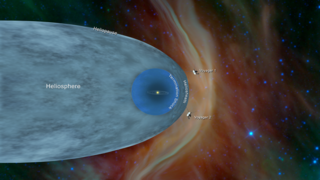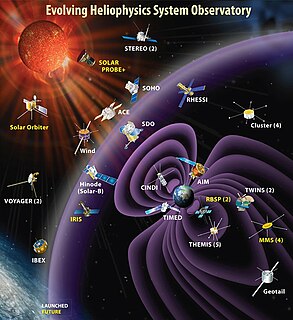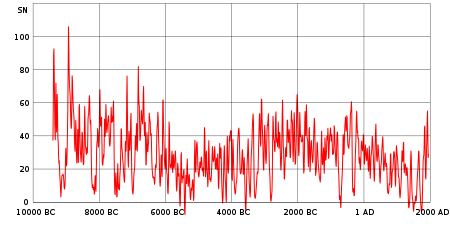
The ionosphere is the ionized part of Earth's upper atmosphere, from about 48 km (30 mi) to 965 km (600 mi) altitude, a region that includes the thermosphere and parts of the mesosphere and exosphere. The ionosphere is ionized by solar radiation. It plays an important role in atmospheric electricity and forms the inner edge of the magnetosphere. It has practical importance because, among other functions, it influences radio propagation to distant places on the Earth.

The solar wind is a stream of charged particles released from the upper atmosphere of the Sun, called the corona. This plasma mostly consists of electrons, protons and alpha particles with kinetic energy between 0.5 and 10 keV. The composition of the solar wind plasma also includes a mixture of materials found in the solar plasma: trace amounts of heavy ions and atomic nuclei such as C, N, O, Ne, Mg, Si, S, and Fe. There are also rarer traces of some other nuclei and isotopes such as P, Ti, Cr, 54Fe and 56Fe, and 58Ni, 60Ni, and 62Ni. Superposed with the solar-wind plasma is the interplanetary magnetic field. The solar wind varies in density, temperature and speed over time and over solar latitude and longitude. Its particles can escape the Sun's gravity because of their high energy resulting from the high temperature of the corona, which in turn is a result of the coronal magnetic field.

Space weather is a branch of space physics and aeronomy, or heliophysics, concerned with the time varying conditions within the Solar System, including the solar wind, emphasizing the space surrounding the Earth, including conditions in the magnetosphere, ionosphere, thermosphere, and exosphere. Space weather is distinct from but conceptually related to the terrestrial weather of the atmosphere of Earth. The term space weather was first used in the 1950s and came into common usage in the 1990s.

A geomagnetic storm is a temporary disturbance of the Earth's magnetosphere caused by a solar wind shock wave and/or cloud of magnetic field that interacts with the Earth's magnetic field.

A whistler is a very low frequency or VLF electromagnetic (radio) wave generated by lightning. Frequencies of terrestrial whistlers are 1 kHz to 30 kHz, with a maximum amplitude usually at 3 kHz to 5 kHz. Although they are electromagnetic waves, they occur at audio frequencies, and can be converted to audio using a suitable receiver. They are produced by lightning strikes where the impulse travels along the Earth's magnetic field lines from one hemisphere to the other. They undergo dispersion of several kHz due to the slower velocity of the lower frequencies through the plasma environments of the ionosphere and magnetosphere. Thus they are perceived as a descending tone which can last for a few seconds. The study of whistlers categorizes them into Pure Note, Diffuse, 2-Hop, and Echo Train types.

The heliosphere is the magnetosphere, astrosphere and outermost atmospheric layer of the Sun. It takes the shape of a vast, bubble-like region of space. In plasma physics terms, it is the cavity formed by the Sun in the surrounding interstellar medium. The "bubble" of the heliosphere is continuously "inflated" by plasma originating from the Sun, known as the solar wind. Outside the heliosphere, this solar plasma gives way to the interstellar plasma permeating the Milky Way. As part of the interplanetary magnetic field, the heliosphere shields the Solar System from a significant amount of cosmic rays, including hazardous ionizing radiation. Its name was likely coined by Alexander J. Dessler, who is credited with first use of the word in scientific literature in 1967. The scientific study of the heliosphere is heliophysics, which includes space weather and space climate.
The Committee on Space Research (COSPAR) was established in 1958 by the International Council for Scientific Unions (ICSU). Among COSPAR's objectives are the promotion of scientific research in space on an international level, with emphasis on the free exchange of results, information, and opinions, and providing a forum, open to all scientists, for the discussion of problems that may affect space research. These objectives are achieved through the organization of symposia, publication, and other means. COSPAR has created a number of research programmes on different topics, a few in cooperation with other scientific Unions. The long-term project COSPAR international reference atmosphere started in 1960; since then it has produced several editions of the high-atmosphere code CIRA. The code "IRI" of the URSI-COSPAR working group on the International Reference Ionosphere was first edited in 1978 and is yearly updated.

This is a list of meteorology topics. The terms relate to meteorology, the interdisciplinary scientific study of the atmosphere that focuses on weather processes and forecasting.

The Solar Dynamics Observatory (SDO) is a NASA mission which has been observing the Sun since 2010. Launched on 11 February 2010, the observatory is part of the Living With a Star (LWS) program.
Space physics, also known as solar-terrestrial physics or space-plasma physics, is the study of plasmas as they occur naturally in the Earth's upper atmosphere (aeronomy) and within the Solar System. As such, it encompasses a far-ranging number of topics, such as heliophysics which includes the solar physics of the Sun: the solar wind, planetary magnetospheres and ionospheres, auroras, cosmic rays, and synchrotron radiation. Space physics is a fundamental part of the study of space weather and has important implications in not only to understanding the universe, but also for practical everyday life, including the operations of communications and weather satellites.

Heliophysics is the physics of the Sun and its connection with the Solar System. NASA defines heliophysics as "(1) the comprehensive new term for the science of the Sun - Solar System Connection, (2) the exploration, discovery, and understanding of Earth's space environment, and (3) the system science that unites all of the linked phenomena in the region of the cosmos influenced by a star like our Sun."

The interplanetary magnetic field (IMF), now more commonly referred to as the heliospheric magnetic field (HMF), is the component of the solar magnetic field that is dragged out from the solar corona by the solar wind flow to fill the Solar System.
Geomagnetically induced currents (GIC), affecting the normal operation of long electrical conductor systems, are a manifestation at ground level of space weather. During space weather events, electric currents in the magnetosphere and ionosphere experience large variations, which manifest also in the Earth's magnetic field. These variations induce currents (GIC) in conductors operated on the surface of Earth. Electric transmission grids and buried pipelines are common examples of such conductor systems. GIC can cause problems, such as increased corrosion of pipeline steel and damaged high-voltage power transformers. GIC are one possible consequence of geomagnetic storms, which may also affect geophysical exploration surveys and oil and gas drilling operations.

Energetic neutral atom (ENA) imaging, often described as "seeing with atoms", is a technology used to create global images of otherwise invisible phenomena in the magnetospheres of planets and throughout the heliosphere, even to its outer boundary. This constitutes the far-flung edge of the solar system.
The Institute of Atmospheric Physics AS CR, also designated as the IAP, is part of the Academy of Sciences of the Czech Republic (AS CR). Within the IAP research institutions are combined in order to cover the whole field of science and humanities.
The Arctowski Medal is awarded by the U.S. National Academy of Sciences "for studies in solar physics and solar-terrestrial relationships." Named in honor of Henryk Arctowski, it was first awarded in 1969.

The Heliophysics Science Division of the Goddard Space Flight Center (NASA) conducts research on the Sun, its extended solar system environment, and interactions of Earth, other planets, small bodies, and interstellar gas with the heliosphere. Division research also encompasses geospace—Earth's uppermost atmosphere, the ionosphere, and the magnetosphere—and the changing environmental conditions throughout the coupled heliosphere.

Heliophysics is an aspect of NASA science that enables understanding the Sun, heliosphere, and planetary environments as a single connected system. In addition to solar processes, this domain of study includes the interaction of solar plasma and solar radiation with Earth, the other planets, and the galaxy. By analyzing the connections between the Sun, solar wind, and planetary space environments, the fundamental physical processes that occur throughout the universe are uncovered. Understanding the connections between the Sun and its planets will allow for predicting the impacts of solar interaction on humans, technological systems, and even the presence of life itself. This is also the stated goal of Science Mission Directorate's Heliophysics Research.

Michael Lockwood FRS is a Professor of Space Environment Physics at the University of Reading.

Solar phenomena are the natural phenomena occurring within the magnetically heated outer atmospheres in the Sun. These phenomena take many forms, including solar wind, radio wave flux, energy bursts such as solar flares, coronal mass ejection or solar eruptions, coronal heating and sunspots.


















